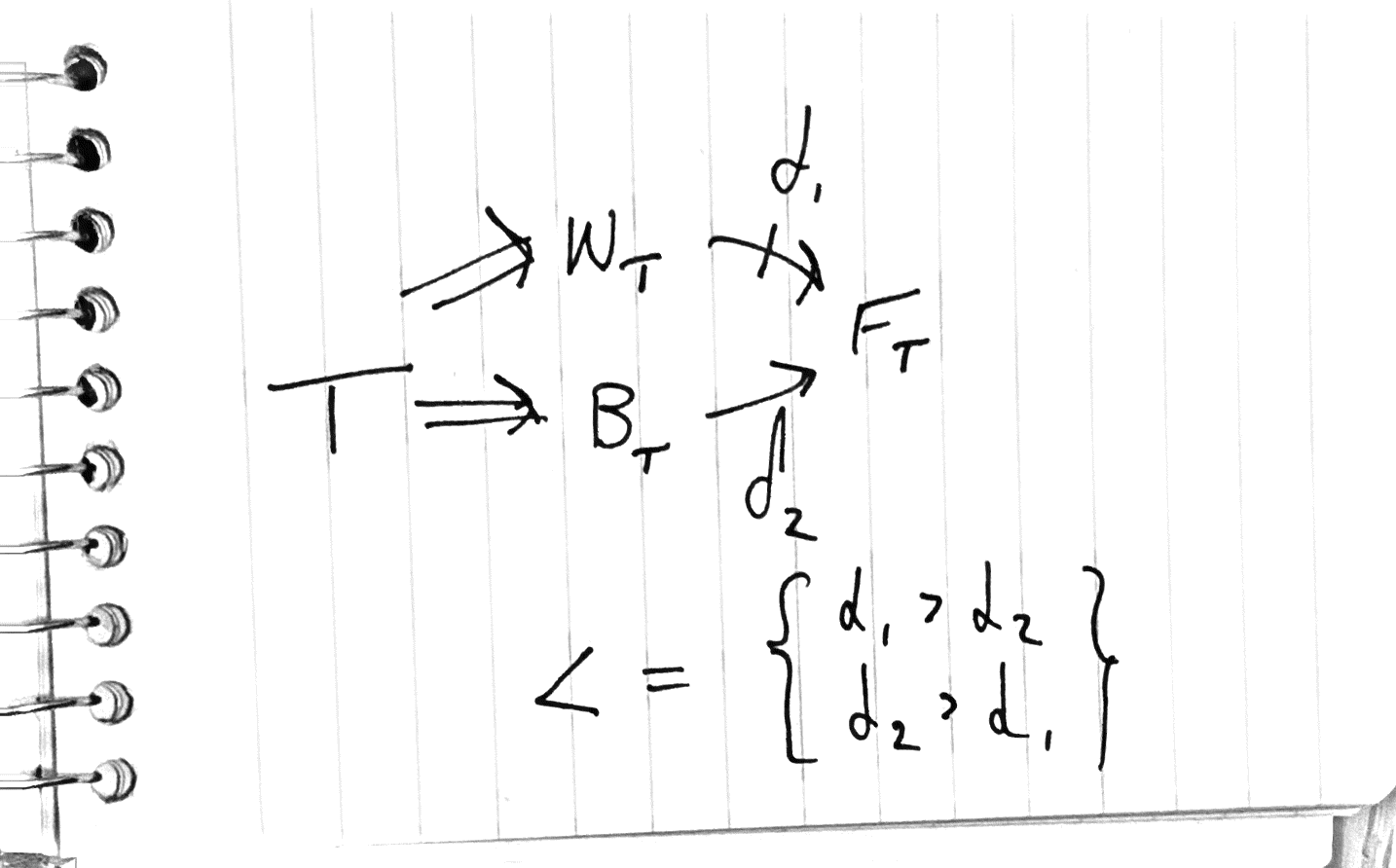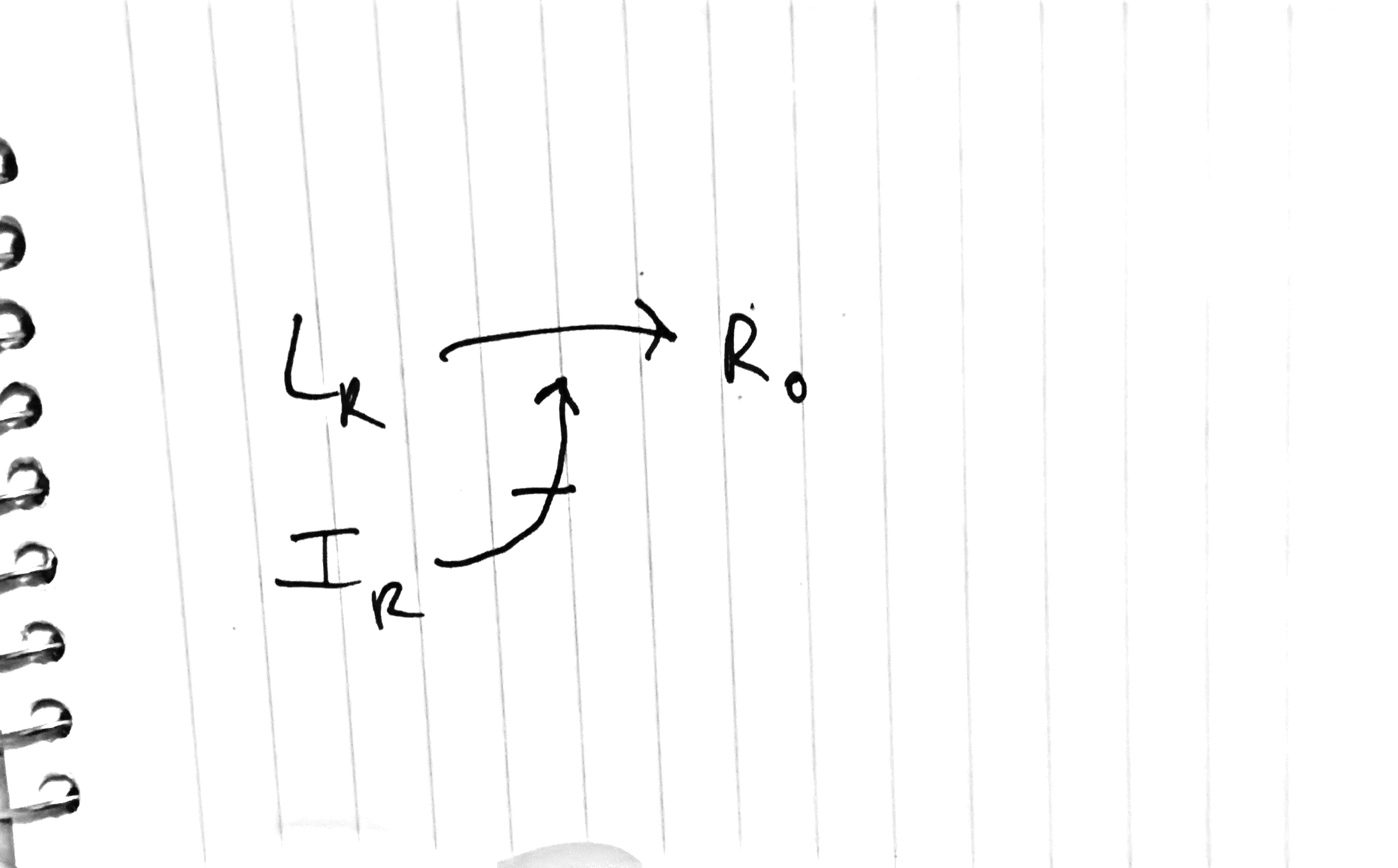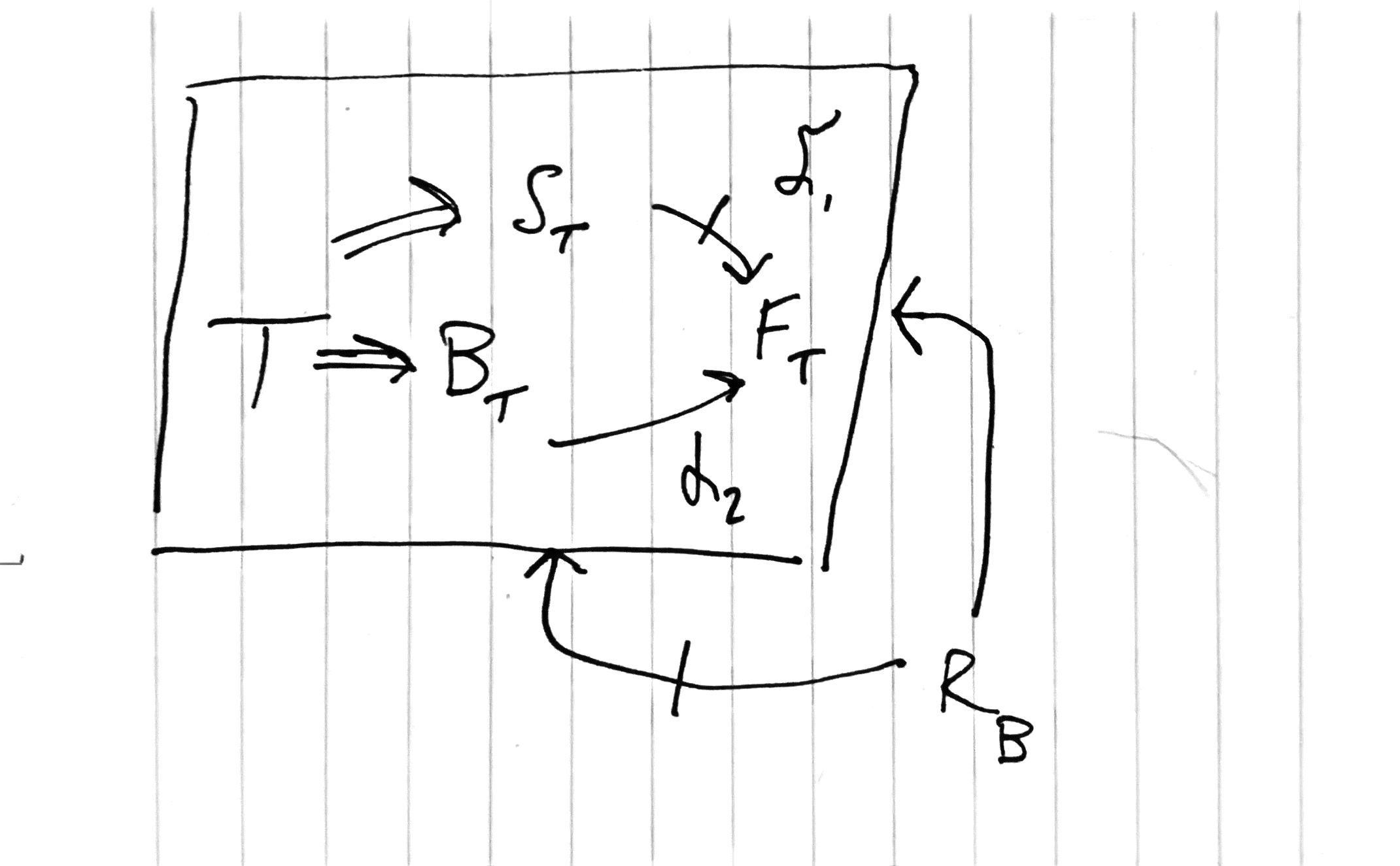
Jul 24, 2019 Tags: philosophy
This post is at least a year old.
About a year ago, I wrote a short-ish post on concerns surrounding two kinds of conflicting views (colloquially “disagreements”). Towards the end, I suggested that categorizing disagreements as “in the language” (i.e., language-language) vs. “outside of the language” (i.e., language-metalanguage) could provide the groundwork for a formal account of faithless argumentation1.
This post will serve as the first of (hopefully) multiple elaborations on that suggestion. In particular, I’ll use this post to investigate the use of “undercutting” semantics to formally express language-metalanguage disagreements. I will also propose (without evidence) that a correct metalanguage exists, as well as make some exploratory claims about the properties of the correct metalanguage. I will also identify problems with the account as a whole.
The terms “faithless” and “bad faith” have rich philosophical and legal histories. To avoid any confusion about what exactly I mean when I use them, they are defined for the purposes below here:
Faithlessness is a property of some actor, in the context of some disagreement2, such that the actor is not committed to the metalanguage that the disagreement exists in.
Bad faith is a property of some actor, in the context of some disagreement, such that the actor is consciously committed to some contravening metalanguage.
Understood as such, bad faith actors can be said to be a strict subset of faithless actors: faithless actors might not be committed to any particular opposing metalanguage, while bad faith actors are committed to a specific alternative.
To begin, observe that “disagreements” often3 take the form of default theories, e.g.:
Carol: Can Tweety fly?
Alice: Yes.
Bob: Nope, Tweety can’t fly.
Alice: Why not? Tweety is a bird, and birds generally fly.
Bob: Not this one: Tweety’s wing is hurt, and birds with hurt generally wings don’t fly.4
Represented as an inheritance network5:

“Tweety is a bird” and “Tweety’s wing is hurt” are pieces of hard information. “Birds fly” and “Things with hurt wings don’t fly” are defaults that follow from each piece of hard information.
Why not represent disagreements in a monotonic logic, where indefeasability might be less of a problem? Three reasons stand out:
Disagreements and their conclusions are, to a certain extent, inherently non-monotonic. Given an individual (or even shared) conclusion after a disagreement, neither party is formally bound to their conclusions as novel ground truth for all future theories. Concretely: in the traditional Tweety Triangle, most people would see no problem with the following chain of reasoning:
Alice: Tweety is a bird, and birds generally fly. Therefore, Tweety can fly.
Bob: But Tweety’s a penguin, and penguins generally can’t fly.
Alice: Oh, then I guess Tweety can’t fly.
Given the information available at the time, it’s difficult to find fault with Alice’s first conclusion. Moreover, given the addition of new information:
Carol: Haven’t you forgotten about Tweety’s gene therapy? The doctor says that the gene therapy is almost always successful.
our conclusion is inverted again6, still with no discernible fault in Alice’s reasoning.
While individuals frequently disagree about what the ground truths are7, it is difficult, given some common ground truth, to produce interesting disagreements. For example:
Edmund: I think Frank is married.
Daphne: Bachelors are unmarried men. Do you agree?
Edmund: Yes.
Daphne: And Frank is a bachelor, right?
Edmund: Yeah.
Daphne: So Frank is unmarried.
What else can Edmund do but agree? He can be proud and refuse to admit it, but the ground truth is clear. This kind of “disagreement” is not even remotely interesting — it just doesn’t look like any of the disagreements we really have on a day-to-day basis.
Many of us have reservations about even our strongest beliefs. In other words, given a strong enough contravening default, many of us would change our minds about things we treat as ground truth. These reservations are rational — most of us understand that our beliefs change over time, and expect this to happen without fundamentally questioning our capacity for reasoning.
So we see that disagreements, or at least many interesting ones, behave like default theories.
So, how do we reason about this scenario?
George: Can Tweety fly?
Hannibal: Yes! Tweety is a bird, and birds generally fly.
Hamilcar: I don’t think so. Tweety is sick, and usually doesn’t fly when sick.
Inez: Birds aren’t real.
Inez’s claim doesn’t fit cleanly into our current semantics. We need a way to represent claims that, if admitted for consideration, undermine the disagreement as a whole: if Inez is right, then talking about what Tweet is or can do as a bird is absurd.
Pollock’s undercutting semantics8 offer themselves: instead of merely offering multiple routes to a conclusion (or its negation), a default can also undercut another default. Consider (a version of) Pollock’s red object:
Jordan: The chair is red because it looks red.
Katya: You can’t trust your eyes. The chair is illuminated by red light.9
Represented as a theory:

Undercutting semantics allow us to represent far richer disagreements without leaving default logic. But observe: Inez’s claim is even more substantial than a “normal” undercutting default: she doesn’t even entertain the world in which birds exist, much less the one in which things called birds might generally fly. Not only do birds not fly, but birds also do not not fly.
I propose this representation of the Inez theory:

Inside the box is the language; outside is the metalanguage. Inez is not committed to the language in which birds are real; she is a faithless participant in the “disagreement”.
This account is not without problems.
I’ve abused the syntax of inheritance networks above: “birds are not real” is not a default (“generally, birds are not real” is not very sensible). I could use double-lined arrows to indicate that these are ground-truth claims, but that would also be a bit weird (and not perfect either, since claims in the metalanguage certainly can be defaults).
In my original post, I proposed:
[…] it’s not the case that a disagreement, when vocalized, must be a direct expression of contradicting beliefs: we are content to call beliefs whose entailments conflict “disagreements”.
This presents a problem for conflicting metalanguages: for a language-metalanguage “disagreement” like the Inez theory, both “birds are real” and “birds are not real” are present in the entailment sets of their respective sides. But this, according to my original claim, suffices for reducing the “disagreement” back into a language-language one.
One “solution” is to define away metalanguage entailment: for a given set of conflicting beliefs, each side’s entailment set is composed only of entailments in their respective languages and not their metalanguages. But this is unintuitive:
What is the right metalanguage?
In the Inez theory, the answer is straightforward: birds are real. Inez is welcome to disagree about whether or not Tweety can fly, but her serious claims about the unreality of birds can be safely ignored.
Things are harder in the moral domain, but maybe not indefeasible. One solution is to pick an ethical system and “promote” it into the metalanguage10. Thus, an ethical disagreement under the metalanguage of utilitarianism:
Lucie: Our company will match your donations, so long as you agree on a cause.
Monice: In order to do the most good, we should buy mosquito nets.
Nicholas: I don’t think so. In order to do the most good, we should give to the local food bank.
And a faithless “disagreement” under the same metalanguage:
Monice: In order to do the most good, we should buy mosquito nets.
Nicholas: We shouldn’t think about it in terms of the most good. Let’s do what we think a good person in our shoes would do.
The fact that the second “disagreement” is faithless is not evidence for the metalanguage’s correctness. What’s more, the faithlessness of this “disagreement” does not imply that all disagreements about ethical systems are in some sense faithless — instead, it suggests that we should perform much more explicit metaethical reasoning.
And as for my own opinion? I don’t believe that the right metalanguage is the language of utilitarian metaethics. I think that the right metalanguage contains two parts:
But those are big claims, and I’ll justify them in another post.
Are we obligated to argue with people whose metalanguage we know (or perhaps merely think, with good reason) to be incorrect?
I don’t think we’re obligated to engage in faithless “disagreements,” and we may even be obligated to not engage in arguments undertaken in bad faith.
But that isn’t the same as ignoring the alternative metalanguage entirely, and I think the latter is too extreme. Instead, insofar as any of us would like to engage with a claim in the metalanguage, we would do best to response with a competing claim in an alternative metalanguage. Using the Lucie example:
Monice: In order to do the most good, we should buy mosquito nets.
Nicholas: It’s plausible that buying mosquito nets might do the most good, but I don’t think doing the right thing is the same as doing the most good.
This has two nice effects: it collapses the language-metalanguage “disagreement” into a true language-language disagreement12 and, more cynically, it lets the other person know that you know what they’re up to.
Given this formalization, can we use it to fix (or at least improve) the process of disagreement?
I’m not sure. By recognizing “disagreements” that stem from alternative metalanguages, we might better preempt some of our worst argumentative tendencies.
Employed faithfully, recognition of the metalanguage(s) involved in a scenario can help us better segregate ethical claims from their respective metaethical systems. Virtually all of us agree that murder, torture, and greed are wrong despite widely varying personal ethical views; it might be more productive to engage more directly with the objects of “good”, “bad”, “right”, “wrong”, &c than to waste time finding edge cases in individual beliefs.
There are many things that could be elaborated on in this post, but it’s already at the inflection point of “too long to ask my friends to suffer through” and “too thinly spread.”
Instead, I’ll just point out a few things:
There are many nonmonotonic systems, virtually all of which have interesting properties that are desirable/intuitive in some cases and undesirable/unintuitive in others. One that I find interesting but didn’t engage with whatsoever in this post is Dung 199513.
While writing this, I’ve become increasingly concerned that my use of “faithless” and “bad faith” are extremely misleading. I chose them originally for partially rhetorical purposes, but am concerned that doing so threatens to delegitimize scenarios like the second Monice/Nicholas one (i.e., where one agent is not committed to the metalanguage, but where noncommittance just might not be that important).
Kant and Popper, among many others, offer parallel constructions. I’ll summarize and contrast them in a future post14.
Or, more weakly, some particular kinds of faithless argumentation. ↩
The term disagreement without quotes is used here and after to only disagreements “in the language,” and not language-metalanguage “disagreements” (with quotes). See the original post for justification. ↩
I’m not prepared to claim categorically that all disagreements are representable in some default language. ↩
This is the Nixon Diamond. See Reiter and Criscuolo 1981. ↩
The syntax here is borrowed from Horty and Thomason 1988, which in turn borrows it from semantic inheritance networks. ↩
And potentially more profoundly: not only can Tweety fly, but she can fly for reasons that potentially explode our original default. ↩
In other words, disagree about what the correct metalanguage is. ↩
See Pollock 1992. ↩
Observe that something being illuminated by red light undercuts just “looks red” and nothing else. Red objects can be illuminated by red light; the fact that the light is red tells us nothing about the object itself. ↩
In other words, take its metaethical claims and express them as either defaults or ground truths. ↩
This is hand-wavey: it should be immediately obvious that we don’t (despite our best efforts) have an incredible amount of hard information. Many plausible remedies exist; I think that some sort of ontological web makes some intuitive sense. ↩
Two conflicting metalanguage claims are a language-language disagreement in the sense that they are ontologically even, i.e. neither seeks the undercut the other’s world. Whether there exists an ontologically prior or apex metalanguage is a separate question, maybe for another post. ↩
Mostly because I have a hard time understanding it. ↩
Read: my books are packed up and I can’t find the pages right now. ↩